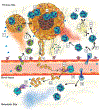Getting TANned: How the tumor microenvironment drives neutrophil recruitment
- PMID: 30549315
- PMCID: PMC8193910
- DOI: 10.1002/JLB.3RI0718-282R
Getting TANned: How the tumor microenvironment drives neutrophil recruitment
Abstract
The directed migration of neutrophils to sites of injury or infection is mediated by complex networks of chemoattractant-receptor signaling cascades. The recent appreciation of neutrophils as active participants in tumor progression and metastasis has drawn attention to a number of chemokine-receptor systems that may drive their recruitment to tumors. However, the dynamic nature of the tumor microenvironment (TME) along with the phenotypic diversity among tumor-associated neutrophils (TANs) call for a more comprehensive approach to understand neutrophil trafficking to tumors. Here, we review recent advances in understanding how guidance cues underlie neutrophil migration to primary and secondary tumor sites. We also discuss how the presence of other myeloid cells, such as functionally diverse subsets of tumor-associated macrophages (TAMs), can further influence neutrophil accumulation in tumors. Finally, we highlight the importance of hypoxia sensing in localizing TAMs and TANs in the tumor niche and provide a cohesive view on how both myeloid cell types shape TME-associated extracellular matrix organization, which in turn contribute to tumor progression.
Keywords: cancer; chemokines; chemotaxis; leukocyte tumor interactions; monocytes/macrophages; neutrophils; signal transduction; signaling cascade.
©2018 Society for Leukocyte Biology.
Conflict of interest statement
Conflict of Interest Disclosure
The authors report no conflict of interest.
Figures


References
Publication types
MeSH terms
Grants and funding
LinkOut - more resources
Full Text Sources
Miscellaneous

